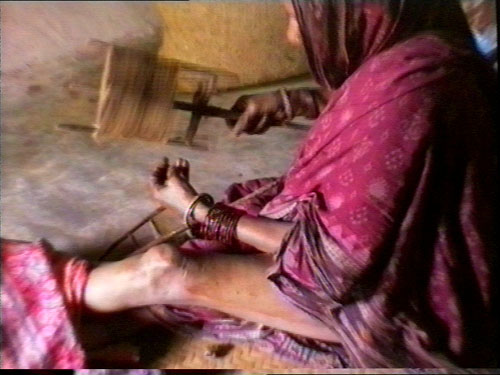Silk Reeling
In general silk reeling is defined as unwinding of silk cocoon. However it is technically defined as the process of finding the right end of the cocoon filament and jointly taking several ends together to reel raw silk. These processes are carried using reeling machines.
Depending on the size of the yarn required to be produced, filament from the cocoons are drawn out simultaneously, compacted and wound on to a reel. For example, if 20 / 22 denier yarn is required, filaments from 8 to 9 cocoons are drawn out simultaneously, compacted and wound.
Silk Reeling broadly has these operations:
a. Catching the correct number of threads to maintain the denier
This is done using a mechanism called Jettebout.
b. Intertwining of threads
This is done using a special mechanism called croissure. Croissure also squeezes most of the water contained in the filament. If the sericin is wet, the threads wound on the reel will stick to each other and defects like hand gum spots result.
c. Distribution of the yarn
This is done using an arrangement called distributor or traverse.
d. Winding of the Yarn
This is done on reels
Quality of Water used in reeling
The water used for silk reeling should be free from impurities as many animal fibres like silk have a decided tendency to fix any substance found in water. Such water alters the appearance of the fibre as its luster becomes dull and matte, thus reducing the quality of the silk.
Reeling of Tusssar
Tassar reeling is not carried out in filature like mulberry cocoons. Mostly it is done in small quantities by the womenfolk of weaver’s family.
Lacing and Skeining
Lacing
In this process the two ends of the silk hank are tied with coloured thread. Lacing is a process in which a thread passing across the hank in such a way so as to devide it into five equal parts. So that the threads are kept in place to ensure that the thread can be unwound easily. For differenciating different denier of silk different coloured threads are used.
Skeining
It is done by twisting the hank several times and folding it upon itself in a number of spirals.
Book Making and Bailing
The skeins are made into neat books of approximately equal weight and dimensions in a bookmaking machine. In each book there are eight skeins in the horizontal row and five in the vertical row.
Thanks for your attention. Did you find the information you were looking for ? Please leave a comment. Do you need to know more ? Please suggest a topic in the comments. You can also join the Forum for your specific queries.
In general silk reeling is defined as unwinding of silk cocoon. However it is technically defined as the process of finding the right end of the cocoon filament and jointly taking several ends together to reel raw silk. These processes are carried using reeling machines.
Depending on the size of the yarn required to be produced, filament from the cocoons are drawn out simultaneously, compacted and wound on to a reel. For example, if 20 / 22 denier yarn is required, filaments from 8 to 9 cocoons are drawn out simultaneously, compacted and wound.
Silk Reeling broadly has these operations:
a. Catching the correct number of threads to maintain the denier
This is done using a mechanism called Jettebout.
b. Intertwining of threads
This is done using a special mechanism called croissure. Croissure also squeezes most of the water contained in the filament. If the sericin is wet, the threads wound on the reel will stick to each other and defects like hand gum spots result.
c. Distribution of the yarn
This is done using an arrangement called distributor or traverse.
d. Winding of the Yarn
This is done on reels
Quality of Water used in reeling
The water used for silk reeling should be free from impurities as many animal fibres like silk have a decided tendency to fix any substance found in water. Such water alters the appearance of the fibre as its luster becomes dull and matte, thus reducing the quality of the silk.
Reeling of Tusssar
Tassar reeling is not carried out in filature like mulberry cocoons. Mostly it is done in small quantities by the womenfolk of weaver’s family.
Lacing and Skeining
Lacing
In this process the two ends of the silk hank are tied with coloured thread. Lacing is a process in which a thread passing across the hank in such a way so as to devide it into five equal parts. So that the threads are kept in place to ensure that the thread can be unwound easily. For differenciating different denier of silk different coloured threads are used.
Skeining
It is done by twisting the hank several times and folding it upon itself in a number of spirals.
Book Making and Bailing
The skeins are made into neat books of approximately equal weight and dimensions in a bookmaking machine. In each book there are eight skeins in the horizontal row and five in the vertical row.
Thanks for your attention. Did you find the information you were looking for ? Please leave a comment. Do you need to know more ? Please suggest a topic in the comments. You can also join the Forum for your specific queries.

